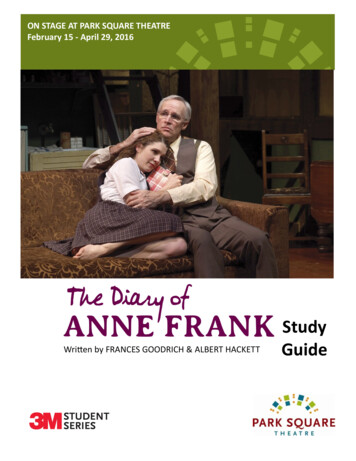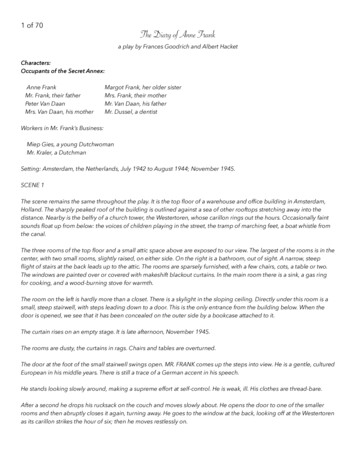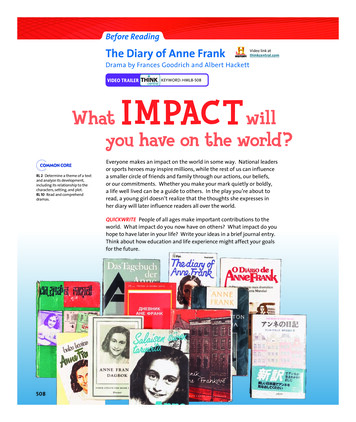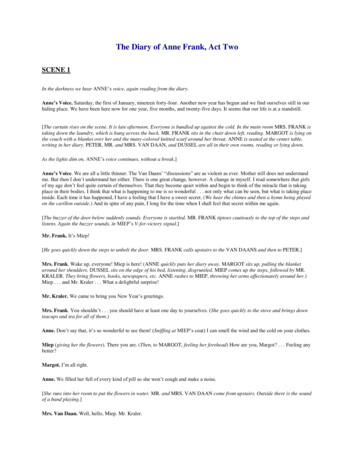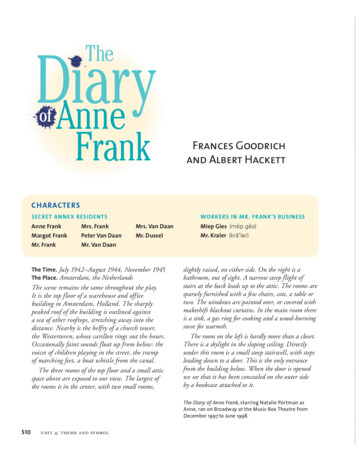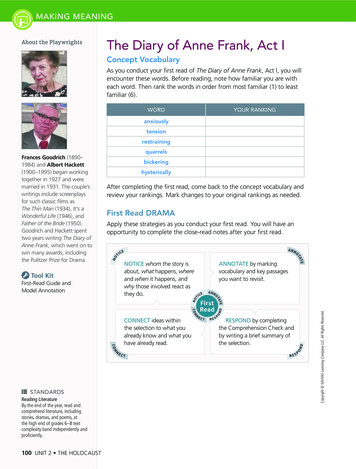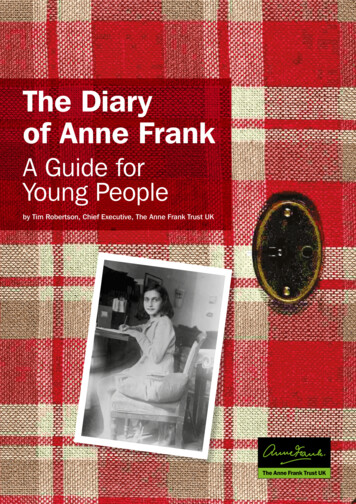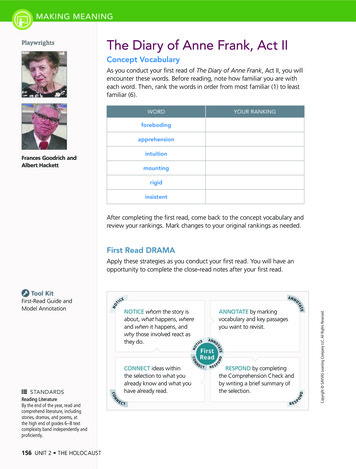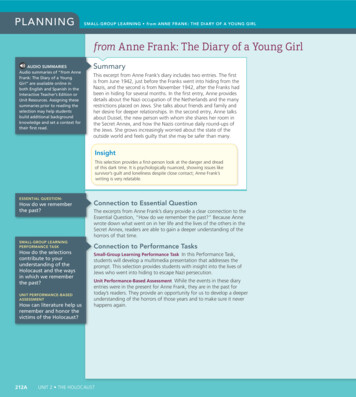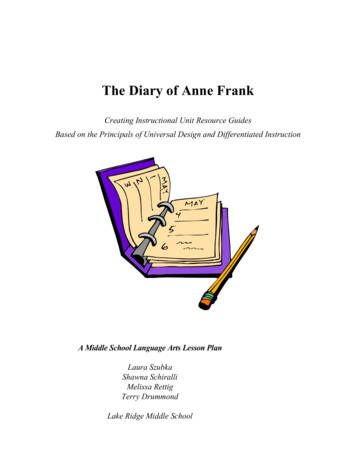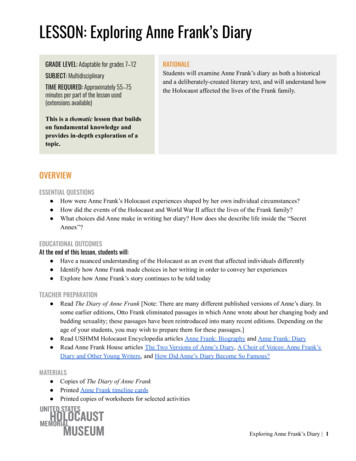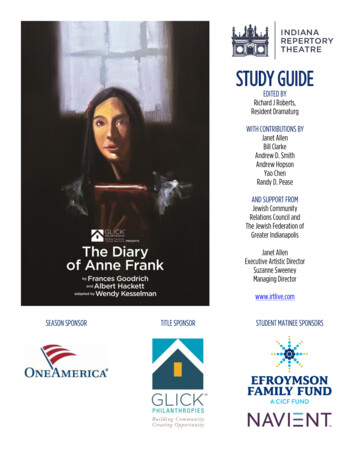
Transcription
STUDY GUIDEEDITED BYRichard J Roberts,Resident DramaturgWITH CONTRIBUTIONS BYJanet AllenBill ClarkeAndrew D. SmithAndrew HopsonYao ChenRandy D. PeaseAND SUPPORT FROMJewish CommunityRelations Council andThe Jewish Federation ofGreater IndianapolisJanet AllenExecutive Artistic DirectorSuzanne SweeneyManaging Directorwww.irtlive.comSEASON SPONSORTITLE SPONSORSTUDENT MATINEE SPONSORS
The Diary of Anne Frank by Frances Goodrich and Albert Hackett adapted by Wendy KesselmanIn a world turned upside down by the Holocaust, Anne Frank held on to her faith in humanity. This story of resilience, optimism, anda young girl’s extraordinary spirit transcends time and offers hope to today’s world.As important today as when it was first written, Anne Frank’s extraordinary diary has become an essential part of how we rememberone of the darkest periods of human history. Filled with its young author’s tremendous spirit, we witness the coming-of-age of acomplex young girl and her struggles to survive with her family amid the chaos of war and religious persecution. This inspiringclassic comes to life to introduce a new generation to this powerful story of courage.COVER ART BY KYLE RAGSDALESTUDENT MATINEESESTIMATED LENGTHAGE RANGECONTENT ADVISORY10:00AM on January 22, 23, 24, 25, 28, 29, 30, 31 and February 1, 4, 5, 6, 7, 8, 11, 12, 13, 14, 19, 20, 21, 22Approximately 2 hours, 45 minutesRecommended for grades 6-12The Diary of Anne Frank is a historical drama that contains some adult themes. A script preview is availableupon request.STUDENT MATINEES & ARTIST IN THE CLASSROOMSarah Geis 317-916-4841sgeis@irtlive.comSUMMER WORKSHOPS, CLASSES, & YOUNG PLAYWRIGHTS IN PROCESSRandy D. Pease 317-916-4842rpease@irtlive.comYOUTH AUDITIONScasting@irtlive.comSTUDY GUIDE CONTENTSInformation about the Production3 How to Use this Guide4 Synopsis5 Director’s Note6 Designer Notes8 About the Playwrights9 The Role of the AudienceHistorical Information10 Hitler and World War II11 The Holocaust12 Anne Frank: 1929-194514 Timeline of EventsEducational Materials18 Overview19 Alignment Guide20 Pre-Show Materials21 Post-Show Materials22 Discussion Questions22 Writing Prompts23 Investigating the Holocaust24 Literature Circles25 GlossaryWe are particularly grateful to Glick Philanthropies for their leadership and to staff members at theJewish Federation of Greater Indianapolis, and the Jewish Community Relations Council for their support and assistance:Lindsey Mintz, Marla Topiol, (JCRC), Nina Price, Amber Maze, and Debra Barton-Grant, (JFGI).
INDIANA REPERTORY THEATRE3HOW TO USE THIS GUIDETo enrich your students’ experience at the IRT production of The Diary of Anne Frank, we have compiled various resources inpartnership with the Jewish Federation of Greater Indianapolis (JFGI) and the Indianapolis Jewish Community Relations Council(JCRC). This guide provides an overview of the materials available to you and your students and is designed to aid you in accessingmaterials on a companion website as well as design lesson plans both prior to and following the performance.The guide is divided into three sections: Information about the Production: includes a synopsis of the play, statements by the director and the designers, and a guideto the role of the audience Historical Context: focusing on background about World War II, the Holocaust, and Anne Frank’s story, including a timelinethat can be shared with students Educational Materials: featuring key themes and concepts such anti-Semitism, identity, stereotyping, refugees, and thepower of capturing stories.During the intermission students will have the opportunity to see the travelling exhibit Anne Frank: A History for Today, on loan fromthe Anne Frank House. Volunteer docents will be available to answer students’ questions about the exhibit and the performance inorder to enhance the overall educational experience.If you are seeking additional materials beyond those provided in the guide, we encourage you to contact the following localeducators who have expertise in Holocaust studies and education: Amber Maze, JFGI Holocaust Education & Program Coordinator, amaze@jfgi.org Lindsey Mintz, JCRC Executive Director, lmintz@indyjcrc.org Nina Price, JFGI Director of Jewish Education Initiatives, nprice@jfgi.org Marla Topiol, JCRC Israel and Anti-Semitism Education Coordinator, mtopiol@indyjcrc.orgEnjoy the performance!
4 INDIANA REPERTORY THEATRETHE STORY OF THE DIARY OF ANNE FRANKAct I begins in 1942. The Nazis have occupied the Netherlands and the Frank family – Otto, Edith, Anne, and Margot – have gone intohiding to escape the persecution of Jews. Otto has prepared a special hidden area in the annex of his office in Amsterdam for them tohide in. Only two people are made aware of this hiding space – Miep Gies, Otto’s secretary, and Mr. Kraler, one of the managers in hiscompany. Miep and Mr. Kraler will be the Frank’s only connection to the outside world.Because Otto’s business is still operating, the Frank family must be very careful not to make noise during the day, for fear of beingfound out. In the beginning, Otto and Anne find hiding away in the annex to be novel, and strive to make it a pleasant place to live.Edith and Margot are less enthusiastic.Eventually, a new family called the Van Daans move into the Annex – Hermann, Petronella, Peter and their cat Mouschi. Anne beginsto pursue a friendship with Peter, who is shy and not very receptive. The Van Daans update the Franks on what has been happeningin the outside world, where conditions for Jews haven’t improved. Anne, having begun to feel the strain of living in the Annex hearsthis news and reminds herself that her situation could be much worse.A few months later, Mr. Dussel joins the families in the Annex as a new resident. He brings even more dire news about the war effort.Due to the ever shrinking space, Anne is forced to share her room with Mr. Dussel. Anne begins having nightmares, and the otherresidents worry that her screams may eventually lead to their discovery.Hanukkah arrives and the residents of the Annex enjoy a brief reprieve from the stress of hiding by celebrating together. However,during the party, a loud crashing sound is heard in the business below. Terrified, the residents fall silent. While trying to turn out thelighs, Peter accidentally knocks over a chair, after which the residents hear an intruder run out of the building. After a while, Ottosneaks downstairs into the business to discover that the intruder was a burglar, and not the Gestapo. Relieved, he tries to strike upthe Hanukkah celebration once again, but the moment has passed.Act II begins on January 1, 1944, nearly two years after the Franks initially moved into the Annex. Life in the Annex has becomeroutine. The major change for Anne is that she has matured into a young woman, and has developed feelings for Peter. They beginhaving regular visits – privately – in the attic, much to the enjoyment of the adults, excluding Anne’s mother.Otto Frank learns from Mr. Kraler that an employee has begun asking suspicious questions about the Franks, even going to far as tosuggest he might be aware of the secret entrance to their hiding place. Otto agrees to raise the employee’s salary in hopes ofavoiding extortion, or worse, discovery.As the war continues, life outside the Annex becomes harder, which is only amplified for those in hiding. Rationing means that lessfood makes it to the Annex. Many residents become sick – Margot most of all – and tension builds as everyone struggles to getenough to eat. Things come to a head when Mr. Van Daan is caught stealing bread and Mrs. Frank suggests they be kicked out of theannex.Eventually, Miep brings good news. Allied forces have invaded Normandy, and the end of the war seems imminent. Things begin tolook up. However, it doesn’t last. An anonymous source has betrayed the residents of the Annex, and in August 1944, Nazi soldiersarrive to arrest everyone inside.At the end, Otto Frank, the only survivor, steps forward to tell us of the fates of each resident. He holds Anne’s diary as the light fadeto black.
INDIANA REPERTORY THEATRE5DIRECTOR’S NOTES “A LIGHT IN THE DARKNESS”BY JANET ALLEN, EXECUTIVE ARTISTIC DIRECTORGiven the schedule of our publications calendar, I find myself writing about The Diary of Anne Frank just a few days after theshootings at Pittsburgh’s Tree of Life Synagogue, which left 11 Jewish worshippers dead. One of Tree of Life’s congregants, JudahSamet, who was caught in the crossfire, heard the shooter screaming anti-Semitic curses as he fired his semiautomatic rifle. Samet,who was not injured, had heard and seen these things before: he survived Bergen-Belsen Concentration camp (the same campwhere Anne and Margot Frank died). In an interview with the Chicago Tribune, Samet said: “I know not to depend on humanity.” Inreading that, I couldn’t help but think that, had she survived, Anne Frank could have been one of those 92-year-old worshippers inPittsburgh.We are reminded far too often these days of the extent to which humanity betrays itself with violence and hate. The commonness ofit grows overwhelming. My family made a pilgrimage to Auschwitz last December: the steel-gray skies and snow-covered groundsmade it very easy to feel the horror that engulfed its inhabitants. Yet at the same time, the experience is numbing,incomprehensible, all too easy to push away. Today, the Holocaust is taught in some circles merely as one more in a long line ofhistory’s genocides, and not the most recent at that. It is perhaps easy to wonder if Anne Frank’s message still resonates. Even in 2011when we last produced this play, we were shocked by the number of people who asked, in post-show discussions, if the events ofthe play were based on actual history. How is it possible that anyone could question that? Is Anne’s diary fading as the totem ofhistory’s worst catastrophe of hate? I don’t think so.But Anne’s diary (like the play) isn’t about hate or even about anti-Semitic rhetoric: it’s about a young teenager coming of age incircumstances made very restricted and, ultimately, tragic, by hate, but who is overwhelmingly caught up in living. And therein liesthe power of her story which, in fact, is full of surging, searching, youthful thoughts. In the words of biographer Francine Prose:Perhaps more than any other book, Anne’s diary reminds us of what bewilderment and yearning were like. The diary entries become a sort of mirror inwhich teenagers, male and female, can see themselves—a capsule description of the alienation, the loneliness, and the torrents of free-floating grief thatdefine adolescence in 20th century Western culture. Older readers will recognize familiar but forgotten echoes from their own pasts as Anne describes herinability to breach the wall that separates her from others. Younger readers may experience an almost eerie kinship with a girl who died so long ago butwho is saying what no one has expressed quite so succinctly. Of course, she is writing about eight Jews forced by the Nazis to spend two years in an attic.But she is also describing what it is like to be young.Anne’s delight in life, her belief in the possibility of her own remarkable future, makes the diary, and the play based on it, all themore poignant these days. Not just because there is a horrible rise of anti-Semitic behavior and rhetoric in our polarized country, butbecause we are witnessing the end of an era in which the people who survived the Holocaust are alive to tell us about it. Again, fromFrancine Prose:In a few more years, no one alive will have witnessed the scene of a Nazi arresting a Jew. There have been, and will be, other arrests and executions for thecrime of having been born into a particular race or religion or tribe. But the scene of Nazis hunting down Jews is unlikely to happen again, though historyteaches us never to say never. This [the arrest of the Franks and Van Daans] will be the arrest that future generations can visualize . They will have toremind themselves that it happened to real people, though these people have survived and will live on, as characters in a book.There is no question that we produce a play like this to put a human face on genocide—for art to stir empathy and understanding inall of us, from children to the elders for whom the Holocaust is more vivid. We produce it with the same unswerving commitment toquality in art-making that we commit to all our work, believing that through that commitment to quality—in creating a captivating,authentic experience for our audiences—we can further move audiences to say what the Jewish people have said for 70 years:“never again.” Never again to any acts of hatred that marginalize a people defined by race, religion, or tribe. Art can change lives. Forthose who may believe that the Holocaust is a waning historical moment, rather than a frighteningly vivid and recurring symptom ofhumanity’s worst attributes, we hope this production can bring understanding and awakening.
6 INDIANA REPERTORY THEATREDESIGNER NOTES “THE SECRET ANNEX”BILL CLARKE SCENIC DESIGNERThe designer’s job here is parallel to that of the Diary’s theatrical adapters: we both start with Anne’s text, and we both work—viaselective choices, condensation, a bit of juggling, and some dramatic highlighting—to bring the secret annex alive onstage. For thisplay I think a set designer’s challenge is to recreate the atmosphere and cramped feeling of eight people living piled atop each otherin a warren of suffocating proximity, yet provide clear sightlines for everyone in the audience to see the play. The annex was in factstacked vertically over three narrow stories, while onstage space must be arranged more horizontally. Anne recorded her smallphysical world with painstaking care, from overall layout to minutest detail, and our goal has been to honor historical reality whilemaking this evening theatrically vibrant and immediate.ANDREW D. SMITH LIGHTING DESIGNERAbout 25 years ago I saw an exhibit of Jewish children’s artwork made during World War II in Terezín Ghetto in Czechoslovakia beforethey were sent to Auschwitz. What struck me was that these pictures looked like any kid’s drawings: a simple house with flowers anda sunny sky, a whimsical undersea world of clams and jellyfish, three girls playing in a yard. These pictures flood my mind as I workon The Diary of Anne Frank. I want the light to reflect the life these eight people still long for, filled with soft daylight, warmlightbulbs at night, and moonlight.Preliminary rendering by scenic designer Bill Clarke
INDIANA REPERTORY THEATRE7ANDREW HOPSON COMPOSER & SOUND DESIGNERI was lying in bed the other night and I realized that over the years I have become really used to the sounds my house makes, andthat when some new sound intrudes it can jolt me from a deep sleep and set my pulse racing. Never being able to leave the annexfor two years, the Franks must have learned every sound their hideout made—the building was several hundred years old, after all—plus all the sounds of the office below them, and the traffic through the neighborhood. Anything out of the ordinary might meanthat they were about to be arrested. After being cooped up for so long, it is hard not to imagine that certain sounds such as gurglingpipes, a squeaky step, or a loose shutter would at first be terrifying, then irrationally infuriating, and finally comforting.YAO CHEN COSTUME DESIGNERThe war forced fashion in the 1940s to be simple and practical. The challenges for me as a costume designer in this production are tofind interest within subtlety, and to respect the historical look while moving the narrative forward at the same time. What is thestory of these pieces of clothing worn on stage? Where are they from? When were they purchased? How worn out is each piece isgoing to be? How can we use the characters’ wardrobes to show the step by step decaying of their physical and psychological selves?I hope the audience can detect the “codes” we hide in the costumes. Finally, as a foreigner in the United States, I am honored by thisopportunity for detailed research and study of this significant chapter in Jewish and world history.Preliminary costume sketches for Anne Frank, Otto Frank, Mrs. Van Daan, Mr. Dussel, and Margot Frank by designer Yao Chen.
8 INDIANA REPERTORY THEATREPLAYWRIGHT AND ADAPTORFRANCIS GOODRICH & ALBERT HACKETT PLAYWRIGHTSFrances Goodrich (1890-1984) and Albert Hackett (1900-1995) met in 1927 in Denver, where both were acting with a stock company.Their first collaborative writing effort was the play Up Pops the Devil, which opened in New York in 1930 and was made into a film in1931, the year the couple married. Over the next three decades, they wrote more than 40 screenplays together, including such classicsas The Thin Man (1934), It’s a Wonderful Life (1946), Easter Parade, (1949), Father of the Bride (1950), and Seven Brides for SevenBrothers (1955). They worked on their stage adaptation of The Diary of Anne Frank for two years, meeting with Otto Frank andvisiting the attic where the Franks had hidden from the Nazis. The play opened on Broadway in 1955, winning both the Tony Awardand the Pulitzer Prize. In 1959, they adapted the play into a film, which won an Academy Award for Shelley Winters as Mrs. van Daan.WENDY KESSELMAN ADAPTORWendy Kesselman is an American playwright. In 1981 she won the Susan Smith Blackburn Prize for her play My Sister in this House,which premiered at the Actors Theatre of Louisville’s Humana Festival. Among her other plays are I Love You, I Love You Not; TheJuniper Tree; Maggie Magalita; and The Notebook. She wrote the 2004 television adaptation of A Separate Peace.Albert Hackett and Francis Goodrich, playwrights for the original adaptation of The Diary of Anne Frank. Image from Google Images.
INDIANA REPERTORY THEATRE9THE ROLE OF THE AUDIENCEYou, the audience, are one of the most important parts of any performance. Experiencing the theatre is a group activity shared notonly with the actors, but also with the people sitting around you. Your attention and participation help the actors perform better, andallow the rest of the audience to enjoy the show. Here are a few simple tips to help make each theatre experience enjoyable foreveryone:Leave mp3 players, cameras, mobile phones, and other distracting and noise-making electronic devices at home.You may think texting is private, but the light and the motion are very annoying to those around you and on stage. Do not textduring the performance.Food and drink must stay in the lobby.The house lights dimming and going out signal the audience to get quiet and settle in your seats: the play is about to begin.Don’t talk with your neighbors during the play. It distracts people around you and the actors on stage. Even if you think theycan’t hear you, they can.Never throw anything onto the stage. People could be injured.Remain in your seat during the play. Use the restroom before or after the show.Focus all your attention on the play to best enjoy the experience. Listen closely to the dialogue and sound effects, and look at thescenery, lights, and costumes. These elements all help to tell the story.Get involved in the story. Laugh, cry, sigh, gasp—whatever the story draws from you. The more emotionally involved you are,the more you will enjoy the play.Remain at your seat and applaud during the curtain call because this is part of the performance too. It gives you a chance torecognize a job well done and the actors a moment to thank you for your attention.
10 INDIANA REPERTORY THEATREHITLER AND WORLD WAR IIBY RICHARD ROBERTS, RESIDENT DRAMATURGAdolf Hitler was born in Austria on April 20, 1889. Early on, Hitler developed an admiration of the German nation and a fascinationwith German culture. Following professional failures in Austria, Hitler moved to Munich in 1913 and eventually joined the GermanImperial Army at the onset of World War I in 1914. While serving in the Imperial Army, his longtime admiration for Germany grewand, after the Central Powers declared defeat, he began to feel that his life’s mission was to “liberate” Germany.The Treaty of Versailles was signed on May 7, 1919, officially ending the First World War. The Western Powers explicitly used theprovisions of the Treaty to punish Germany by depriving the nation of valuable territory and forcing it to pay exorbitant reparations.By 1919, Hitler returned to Munich and joined the Information Office of the Bavarian Military Administration, an intelligence gatheringbranch of the Bavarian Armed Forces, and was tasked with spying on the German Workers Party (DAP). He found that he admired thenew party’s nationalist, anti-capitalist, anti-Marxist, and anti-Semitic ideas, while the party leaders, in turn, were impressed with hisoratory skills and use of propaganda. Hitler joined the DAP in October of 1919 before being honorably discharged from the military inMay of 1920. Hitler quickly rose through the ranks of the party leadership and, by 1921, had named himself Führer of the newly coinedNational Socialist German Workers Party (Nazis).In 1923 Hitler and the Nazi Party failed in their attempt to seize power of Bavaria leading to Hitler’s arrest and imprisonment fortreason. The trial that followed his arrest provided Hitler a platform to share his anti-Semitic viewpoints and nationalist sentiments.His nationalistic speeches at the trial made him famous, and he emerged from a nine-month imprisonment having formulated MeinKampf (My Struggle), which would end up becoming a best-selling autobiography. Central to Hitler’s rising appeal was his ability tocapitalize on Germany’s wounded national pride. When early attempts to blame the Jews for Germany’s woes failed, Hitler began tocombine anti-Semitism with anti-Republic sentiments, and this volatile cocktail worked.By 1932, Hitler’s Nazi party controlled 33% of seats in the Reichstag (German Parliament), and in 1933 Hitler was appointed Chancellorof a coalition government. On the eve of a pivotal election, fire was set to the Reichstag which the Nazi party blamed on Communists.In response, basic civil rights were suspended and Hitler came one step closer to complete dictatorship. In August 1934, when theGerman president died, Hitler’s cabinet appointed him Führer und Reichskanzler (leader and chancellor) of Germany.Hitler capitalized on people’s fear and used his charisma to convince Germans that they needed to be saved from Communists, Jews,and other “undesirable” minorities. He massively expanded the military, started huge infrastructure projects, and bolstered industry,effectively reducing unemployment while masking the financial manipulations that sustained these efforts. Meanwhile, inpreparation for German expansion across Europe, he established an alliance with Mussolini’s Italy and dropped alliances with China infavor of Japan. Hitler focused his efforts on gaining territory that was lost in the Treaty of Versailles, beginning with a unification withAustria and gaining control of the Sudetenland (German speaking Czechoslovakia) through agreements made at the MunichConference. By 1939, Hitler’s vision of creating a pure Aryan territory for ethnic Germans caused Germany to invade Poland, leadingFrance and Great Britain to declare war on Germany.Over the next two years, through military campaigns and treaties, Germany subdued most of continental Europe except the SovietUnion, which was the next target. Meanwhile, in December 1941, Japan attacked the United States at Pearl Harbor. Between the Allies(Great Britain, the Soviet Union, France, the United States and other countries) and the Axis (Germany, Japan, Italy and othercountries), more than 100 million military personnel were mobilized worldwide. The tide of the war began to turn in 1942 withJapanese defeats in the Pacific and German defeats in the Soviet Union and North Africa. By 1943, the Axis Powers were in defensiveretreat. The Allied invasion of Normandy and the Soviet recapture of lost territories in 1944 led to Germany’s surrender and Hitler’ssuicide in May 1945. The atomic bombing of Hiroshima and Nagasaki led to Japan’s surrender in August of that year, effectivelyending the Second World War.
INDIANA REPERTORY THEATRE11THE HOLOCAUSTBY RICHARD ROBERTS, RESIDENT DRAMATURGCentral to Nazi ideology was the concept of Aryan superiority. “Survival of the fittest” was interpreted as a need for racial purity andthe destruction of “life not worthy of life.” At the root of Nazi ideology was anti-Semitism, a prejudice or discrimination against Jews.While the term “anti-semitism” was not in common use until the 19th century, its tenants have been expressed in cultural discoursefor millennia.The history of the Jewish people has been punctuated by tragedies that emerged from a rise in anti-Semitism, which has led somehistorians to refer to anti-Semitism as “the oldest hatred.” The spread of Christianity can often be tied to the spread of anti-Semitismand is linked to events such as the Crusades, the Spanish Inquisition, as well as expulsion of Jews from England, Spain, and Portugal.Other forms of anti-Semitism led to Jewish exclusion from society including the development of ghettos and later the pogroms ofTsarist Russia.After Hitler came to power, he began to restrict the legal, economic, and social rights of Jews within Germany and all annexedterritories. Through these laws, piece by piece, Jews were banned from medicine, agriculture, law, civil service, schools, andjournalism. In 1935, a series of laws known as the Nuremberg Laws were enacted, which stripped Jews of their citizenship, prohibitedJews from marrying Aryans, and denied all Jews their civil rights. While some Jews were able to escape Germany in the early 1930s,the introduction of these laws made it nearly impossible to do so after 1935. When the Nazi party annexed land in Poland,Czechoslovakia, France, and other countries throughout Europe, they instituted these laws and practices targeting Jews.On the night of November 9-10, 1938, Nazi party members and other citizens attacked Jews and vandalized Jewish homes,businesses, and synagogues throughout Germany and parts of Poland and Eastern Europe in what became known as Kristallnacht(the Night of Broken Glass). This increase in violence against Jews was accompanied by legislation in 1939 that attempted to stripJews of their individual identities by forcing them to be identified by a yellow star worn on their clothes at all times. Then, after theinvasion of Poland, the Nazis began to further isolate Jews by forcing them into ghettos in cities such as Warsaw and Lodz.The Nazi ideology of a pure Aryan race led its leadership to develop the “Final Solution to the Jewish Question,” namely a plan for theelimination of all Jews from Europe and beyond. After invading the Soviet Union in 1941, mobile death squads were dispatchedthroughout the conquered territory, rounding up Jews along the way and killing them one by one before burying them in massgraves. While concentration camps for Jews and other “undesirables” had existed throughout the 1930’s, the Nazi leadershipdetermined that a “more efficient” method of killing needed to be established. In late 1941, the Nazis began to build sixextermination camps within occupied Poland for the express purpose of murdering Jews: Chelmno, Majdanek, Auschwitz-Birkenau,Sobibor, Treblinka, and Belzec. As the war neared its conclusion and the Allies began to move towards areas where death campswere located, the Nazis made a final effort to murder Jews by forcing them to participate in long death marches. All told, at least sixmillion Jews, including 1.5 million children, were murdered by the Nazis during the Holocaust.The atrocities of the Holocaust cannot be forgotten. In all, approximately 11 to 14 million people were killed during the Holocaust:non-Jewish Poles, Communists and other political opponents, members of resistance groups, homosexuals, Roma & Sinti (gypsies),the physically and mentally disabled, Soviet prisoners of war, Jehovah’s Witnesses, Adventists, trade unionists and Jews, includingthe young Anne Frank. It is imperative that Anne’s story and those of others continue to be told so that the atrocities of the Holocaustare not forgotten and never repeated.
12 INDIANA REPERTORY THEATREANNE FRANK: 1929-1945BY RICHARD ROBERTS, RESIDENT DRAMATURGAnnelies Marie Frank was born in Frankfurt am Main, Germany, on June 12, 1929, the younger daughter of Otto and Edith Frank. TheFranks were progressive Jews who lived a comfortable life in an assimilated community. When Hitler’s Nazi Party won the localmunicipal council elections in March 1933, anti-Semitic demonstrations began; so later that year, when Otto was offered a job inAmsterdam with Opekta, a pectin company, the family moved. In 1938, Otto opened a second business, Pectacon, a wholesaler ofherbs and spices.In May 1940, Germany invaded the Netherlands, and restrictions against Jews began almost immediately. The Frank’s daughters wereforced to leave public school, and they enrolled in the Jewish Lyceum. Otto took legal steps to protect his businesses fromconfiscation while maintaining a family income. He also began to make plans for the family to go into hiding when it becamenecessary.Anne’s quiet, reserved older sister, Margot, excelled in mathematics, while outspoken, popular Anne preferred writing. For her 13thbirthday in June 1942, Anne received a red-and-green plaid diary that she had recently shown her father in a shop window. Shebegan writing in it almost immediately, addressing her entries to Kitty, a character from a book she had enjoyed. She talked abouther life at school and her friends, as well as her reactions to some of the restrictions on Jews.In July 1942, Margot received a call-up notice ordering her to re
The Diary of Anne Frank by Frances Goodrich and Albert Hackett adapted by Wendy Kesselman In a world turned upside down by the Holocaust, Anne Frank held on to her faith in humanity. This story of resilience, optimism, and a young girl’s extraordinary
